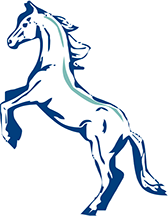

Definition of Equine Sport Therapy
“Torso power before leg power”

Karin Link · Sportpferdetherapeutin · Postfach 1513 · 53705 Siegburg
Mobil +49 (0) 171 - 40 06 121 · www.karinlink.com
Only a free body can work economically and efficiently and manages to achieve peak performance.
The basic requirements are coordination, strength coupled with a sufficient amount of flexibility and endurance. The torso is the centre of it all. Performance and health both depend on it.
If these basic requirements are not given, the result will be fatiguing more quickly and over-acidification
of muscles, which increases the risk of injury. Muscle tension and blockages of joints inhibit the natural movement of the body. Primary or compensatory muscle tension, blockages as well as instabilities lead to evasive movements and a lack of balance! Not only the motion sequences get worse but also the breathing and the metabolism and the organs connected to it. Rides will have consequences when, due to long-lasting biomechanical strains, signs of wear out appear. Retraining or intensifying training becomes more difficult and consistent performance is no longer possible.
However, a stabile torso that is also flexible improves the wellbeing of the horse and, from an athletic
aspect, its performance is increased. Due to the flexibility of the torso and the ribs, organs are able to
work better (respiratory system, cardiovascular system, metabolism) and the movement become smoother, as well as concussion in the limbs can be absorbed and reduced.
At the same time, step length and stride, which are of varying importance and necessity depending on
the discipline, are expanded. Another aspect is prevention in order to maintain a constant performance
level in everyday life as well as on competition days.
The horse’s back mirrors its condition. Primary back pain or compensatory muscle soreness, caused by problems at the limbs or of organic origins, show up at the back. With this “tool,” each horse can clearly
be documented.
Each horse is documented with a base status. And, over a long-term period of care, some interesting
curve shapes can be observed depending on the respective status of the horse.
Two tests to verify flexibility:
1. Testing the flexibility of the ribcage from ventral to dorsal – from the bottom to the top.
The line from the highest point of the withers to approx. the middle of the saddle position is evaluated.
· very bad: „0“: no movement:
The horse drops and twists or pushes downwards with its body
· bad: „1 – 2“: Movement is still restricted by blockages in the spine and muscle tension.
· good to very good: „3 – 4“: The spine nearly forms a straight line, the muscular system is
powerful and flexible.
· insufficient: „5“: The spine forms a straight line but the muscular system is not developed
sufficiently and does not have enough power, i.e. the muscle tone is too low and the horse is
hypermobile.
2. Testing flexibility of the back - Stability of the lumbar vertebrae vs. flexibility of the
withers-saddle position
The line of the back is evaluated beginning with the back part of the croup at the vertebral
segment “S3” to the highest point of the withers.
· very good: The horse forms a minimally deviating straight line from “S3” to the withers.
The horse bends the hindquarters. The croup muscles and the muscles in the lumbar vertebra
area work synchronously, allow movement to flow forward and the ribcage lifts. Each vertebral
segment has mobility.
· medium: When a reflex is triggered, the horse begins to form a kyphosis (uparching) between
the hindquarters area and the lumbar vertebra area. In return the thoracic vertebrae block at the
front part of the saddle position (between “T8—T12”), which build a lordosis. The line of the back
shows a slight to medium S-curve.
· very bad: A strong kyphosis of the lumbar vertebrae all the way to the 14th thoracic vertebra
can be observed. The lumbar spine shows massive instabilities, and the blockages of the front
thoracic vertebrae are increased. A significant S-curve can be seen.
In conclusion, it becomes clear: This view of the use of the back is not only a module in a therapeutic sense. It should rather be incorporated as the basis for the daily work. The body comes alive through movement and only a body that performs efficiently can achieve top performances.